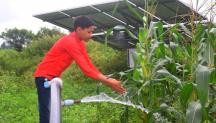The Paris Agreement has called for reducing carbon emissions worldwide. But to sufficiently limit the rise in global temperatures, energy use would have to be completely decarbonised in less than 50 years, even amid the expected tripling of the world’s economy by 2060. This means renewable energy – already growing fast over the past decade – must grow at least seven times faster.
This set of briefs, prepared by the International Renewable Energy Agency (IRENA), highlights challenges and opportunities as the world seeks climate-safe energy solutions.
A combination of renewables and energy efficiency measures will be essential. To keep the temperature rise “well below 2°C” (as per the Paris Agreement), renewables must grow to 65% of global energy supply by 2050, compared to the current 15%, IRENA’s analysis indicates. Around two-thirds of current greenhouse emissions stem from energy production and use, making decarbonisation in this sector crucial to meeting international climate goals. Find out more about
energy decarbonisation.
Governments around the world need to balance the urgency of the energy transition against numerous other considerations that affect people’s welfare. Fortunately, renewable energy provides climate-safe solutions that also support a wide range of socio-economic benefits, including net job creation, health and greater social inclusiveness. Review IRENA’s analysis of
socio-economic benefits.
Meanwhile, the cost of electricity from renewable energy technologies has fallen steadily, and even dramatically, in recent years. This is especially the case since 2000, with the rise of solar and wind power generation as viable commercial options. Today, power generation from renewable sources and technologies has become increasingly competitive with, or indeed, lest costly than, fossil-based or nuclear power. See IRENA’s analysis of renewable energy’s
sharply falling costs.
Even so, for one-third of the world’s anticipated energy use in the coming 20-25 years, no practical decarbonisation solutions currently exist. Research and development (R&D) needs to happen faster, particularly to make renewable energy viable for a wider range of end uses in buildings, heat and transport. Renewable power also requires further innovation to optimise system integration. Learn more about the need for
accelerating research.
These briefs were produced as part of IRENA’s engagement at COP23 – the 23rd Conference of the Parties to the United Nations Framework Convention on Climate Change (UNFCCC), held in Bonn, Germany on 6-17 November 2017.










